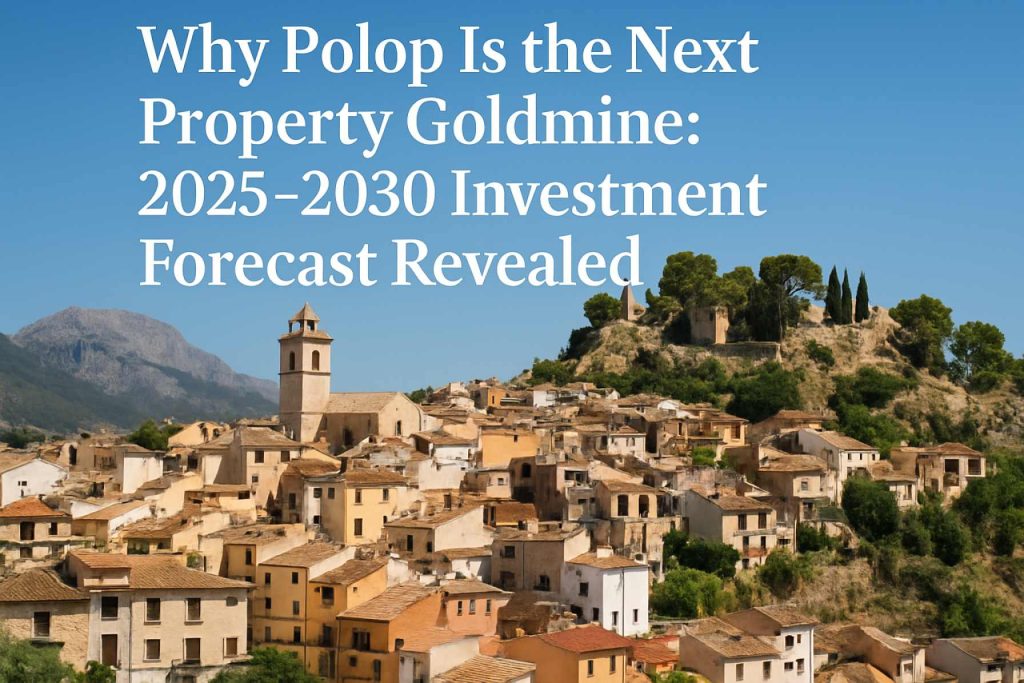
Table of Contents
- 1. Polop’s Strategic Location: Gateway to Costa Blanca Opportunities
- 2. 2025–2030 Market Forecast: Property Values, Rental Yields, and Demand Trends
- 3. Infrastructure Upgrades and Smart City Initiatives: What’s Changing?
- 4. Legal Framework and Tax Incentives for Investors in Polop
- 5. Analysis of New Development Projects: Residential, Commercial, and Mixed-Use
- 6. Technology’s Impact: Proptech, Digital Transactions, and Smart Homes
- 7. Foreign Investment Flows: Who Is Buying and Why?
- 8. Sustainability and Green Building Regulations: 2025 and Beyond
- 9. Risks, Challenges, and How to Mitigate Them
- 10. The Future Outlook: Polop’s Role in Spain’s Real Estate Landscape
- Sources & References
1. Polop's Strategic Location: Gateway to Costa Blanca Opportunities
Polop, situated just inland from the bustling Costa Blanca coastline, is increasingly recognized as a strategic investment location in Spain’s real estate sector. Its proximity to major hubs like Benidorm (10 km) and Alicante (40 km) positions Polop as a gateway to the economic and tourism opportunities of the wider Costa Blanca region. The area is connected by the CV-70 highway and regional bus networks, offering efficient access for residents, tourists, and investors alike. As the Costa Blanca continues to attract international buyers, demand for properties in adjacent, less-saturated areas like Polop is rising, creating new momentum for investment in 2025 and beyond.
Recent data from Instituto Nacional de Estadística shows that the province of Alicante, which includes Polop, saw a 7% increase in residential property transactions in 2024 compared to the previous year, with much of this activity concentrated in suburban and semi-rural municipalities. Local government efforts to streamline urban planning and support sustainable development have further enhanced Polop’s appeal. The Ayuntamiento de Polop has updated its urban plan (PGOU), prioritizing infrastructure upgrades and the development of new residential zones to accommodate anticipated population and investment growth.
For foreign investors, Spain’s robust legal framework continues to ensure security and transparency. The recently revised Ley de Vivienda (Housing Law 12/2023), as outlined by the Boletín Oficial del Estado, imposes stricter regulations on short-term rentals and reinforces tenant protections, particularly in high-demand tourist zones. However, Polop’s current classification outside heavily regulated urban centers means that investment opportunities—both for traditional lets and holiday rentals—remain comparatively flexible.
Looking ahead, infrastructure investment in the Costa Blanca region, including upgrades to transport links and digital connectivity, is set to further integrate Polop into the regional economy. The Diputación de Alicante has earmarked funds for road improvements and sustainable mobility projects through 2027, which are likely to enhance property values and investor returns.
Given these dynamics, Polop stands out as a promising alternative for investors seeking access to Costa Blanca’s lifestyle and economic advantages without the price pressures of prime coastal locations. The combination of favorable regulations, ongoing infrastructure upgrades, and strategic proximity positions Polop as a compelling gateway for real estate investment in 2025 and the coming years.
2. 2025–2030 Market Forecast: Property Values, Rental Yields, and Demand Trends
The outlook for property investment in Polop from 2025 through 2030 is shaped by several converging factors: sustained demand for coastal and semi-coastal real estate in Alicante province, evolving Spanish housing regulations, and the broader economic recovery in the eurozone. Polop, situated inland from the Costa Blanca, continues to attract both domestic and international buyers seeking affordability, lifestyle, and proximity to major tourist hubs.
Recent transactional data from the Colegio de Registradores de España indicates that Alicante province sustained a steady annual growth in home sales throughout 2023 and 2024, with price increases averaging 4.2% year-on-year. Polop’s market performance is buoyed by its relatively low price per square meter compared to coastal municipalities, presenting a value opportunity for investors as prices in larger cities plateau.
Looking forward, the Ministerio de Transportes y Movilidad Sostenible projects continued population inflows into Alicante province, driven by both retirees seeking permanent relocation and remote-working professionals. This demographic trend is expected to underpin demand for both primary and secondary residences, with particular interest in modern villas and townhouses being developed in Polop’s new urbanizations.
Rental yields in Polop are anticipated to remain competitive, particularly for furnished properties catering to medium-term international tenants. According to Idealista, average gross rental yields in the wider Alicante area ranged between 4.5% and 6% in 2024. Projections for 2025–2030 suggest stable or slightly rising yields, as supply remains constrained by limited new construction permits and ongoing demand from seasonal workers, long-stay tourists, and new residents.
Legislative changes, such as the recent updates to Spain’s Ley de Vivienda (Housing Law) introduced in 2023, may impact investor strategies. The law grants autonomous communities, including the Valencian Community, the authority to designate “stressed” rental markets and impose rent caps. However, as of early 2025, Polop has not been classified as a stressed area, allowing for continued rental price flexibility (Generalitat Valenciana). Investors should monitor local government deliberations, as future zoning or regulatory changes could affect both rental and resale markets.
In summary, the 2025–2030 forecast for Polop points to measured capital appreciation, robust rental demand, and a regulatory environment currently favorable to investors. Continued infrastructure improvements and growing international appeal suggest that Polop will remain an attractive option for those seeking solid returns in the Spanish property market.
3. Infrastructure Upgrades and Smart City Initiatives: What’s Changing?
Polop, a picturesque town in Spain’s Alicante province, is undergoing a transformation driven by significant infrastructure upgrades and the adoption of smart city initiatives. These developments are pivotal for investors evaluating real estate and business opportunities in 2025 and beyond.
One of the most impactful projects is the continued rollout of the “Plan de Infraestructuras” coordinated by the Ayuntamiento de Polop. This plan, set to receive further funding through 2025, targets road improvements, expanded public transport connectivity with Benidorm and Altea, and enhanced public spaces. The local government has prioritized sustainable mobility, evidenced by the installation of new cycling lanes and electric vehicle charging stations, aligning with Spain’s national push for green mobility under the “Estrategia de Movilidad Sostenible” by the Ministerio de Transportes y Movilidad Sostenible.
Digital transformation is another anchor of Polop’s modernization. The town has expanded high-speed fiber optic coverage, with partnerships involving local telecoms and the Red.es program. This universal broadband access not only enhances residential value but also attracts remote workers and tech entrepreneurs, supporting a growing sector of the local economy. Smart lighting and waste management systems are being piloted in several neighborhoods, aiming to reduce municipal costs and create a more efficient urban environment.
On the legal front, recent amendments to Spain’s “Ley de Contratos del Sector Público” streamline procurement, making it easier for investors and developers to partner with the municipality on public-private initiatives (Boletín Oficial del Estado). This regulatory clarity is boosting confidence among both domestic and international investors, evidenced by a rise in planning permissions and construction licenses granted in the last two years, as reported by the Ministerio de Vivienda y Agenda Urbana.
Looking ahead, the regional government’s “Plan Vega RenHace” prioritizes resilient infrastructure and digitalization in the Vega Baja area, which includes Polop. These long-term policies are expected to further enhance the town’s appeal for property development and high-tech businesses through 2027 and beyond (Generalitat Valenciana).
In summary, Polop’s ongoing infrastructure projects and smart city initiatives are creating an environment primed for sustainable growth. With robust legal frameworks, improved connectivity, and a focus on digital innovation, the outlook for investors remains highly favorable in 2025 and the coming years.
4. Legal Framework and Tax Incentives for Investors in Polop
Polop, a municipality in the province of Alicante, Spain, continues to attract both domestic and international investors due to its favorable legal environment and tax incentives. As of 2025, Spain’s legal framework for real estate investment remains robust and transparent, governed by national laws with local regulations administered by the regional government of the Valencian Community, which includes Polop.
The principal legal instrument regulating property acquisition in Spain is the Spanish Civil Code, alongside the Royal Decree 1093/1997 regarding property registration. Foreign investors are permitted to acquire real estate in Polop with the same rights as Spanish nationals. The process requires obtaining a Foreigner Identification Number (NIE) and registering the property with the Colegio de Registradores de España. The Consejo General del Notariado ensures transactions are notarized, safeguarding legal certainty.
In 2025, the Gobierno de España maintains the “Golden Visa” program (Ley 14/2013), granting residency to non-EU investors making qualifying real estate purchases of at least €500,000. This program continues to draw significant interest, particularly from investors in the UK, Russia, and China, as confirmed by the Ministerio de Transportes y Movilidad Sostenible.
The Valencian regional government applies specific taxes on property transactions in Polop. The main taxes for investors in 2025 are:
- Property Transfer Tax (ITP): For resale properties, the standard rate in the Valencian Community is 10% of the purchase price (Agència Tributària Valenciana).
- Value Added Tax (IVA): For new properties, VAT is 10%, plus 1.5% in stamp duty (Agència Tributària Valenciana).
- Annual Property Tax (IBI): The local council of Polop levies this tax, based on the cadastral value (Ayuntamiento de Polop).
- Non-Resident Income Tax (IRNR): If the owner is not a tax resident in Spain, income from letting or deemed rental value is taxed at 19% for EU/EEA citizens and 24% for others (Agencia Tributaria).
Looking forward to the next few years, the legal and fiscal landscape in Polop is expected to remain stable. The Spanish government’s continued support for foreign investment and the strong protections afforded by both national and regional laws underpin a positive outlook for investors. Additionally, reforms to streamline digital property registration and notarial services are underway, aiming to further enhance efficiency and security for investors in Polop (Colegio de Registradores de España).
5. Analysis of New Development Projects: Residential, Commercial, and Mixed-Use
In 2025, Polop, a municipality in the province of Alicante, continues to attract attention from investors due to its expanding portfolio of new development projects across residential, commercial, and mixed-use sectors. A combination of favorable local regulations, infrastructure investment, and sustained demand underpins the area’s appeal for both domestic and international buyers.
Recent years have seen a marked increase in residential project launches in Polop. Leading developers such as Grupo VAPF and Sonneil are actively marketing modern villas and apartment complexes, with a focus on sustainable building practices and integrated community amenities. The demand is driven by both lifestyle purchasers and investors seeking rental yields, leveraging the region’s proximity to the Costa Blanca coastline and Benidorm’s urban amenities.
Commercial development in Polop is also evolving, albeit at a more measured pace compared to residential. The Polop Town Hall has prioritized urban regeneration and the expansion of business zones, as outlined in its Municipal Urban Planning Plan (Ayuntamiento de Polop). The plan aims to streamline licensing processes for new commercial ventures and enhance connectivity between residential areas and business districts. This regulatory clarity is expected to encourage small- and medium-sized enterprises to establish operations in the coming years.
Mixed-use projects are emerging as a notable trend, mirroring broader patterns in the Spanish real estate market. These developments typically combine residential units with ground-floor retail and coworking spaces, catering to shifting consumer lifestyles and the rise of remote work. According to the Asociación de Promotores Inmobiliarios de la Comunitat Valenciana (APICE), there is growing investor interest in projects that offer flexible spaces and communal amenities—features increasingly favored by buyers and tenants in 2025.
Legal frameworks governing new developments are stable, with the Ley de Ordenación del Territorio, Urbanismo y Paisaje de la Comunitat Valenciana (LOTUP) providing clear guidelines for zoning, sustainability, and permitting (Generalitat Valenciana). Recent updates streamline administrative procedures and incentivize energy-efficient construction, aligning local projects with EU environmental targets.
Looking ahead, the outlook for investment in Polop’s new developments remains robust. Ongoing infrastructure upgrades, such as improved road links and digital connectivity, are expected to bolster both residential and commercial activity. Coupled with supportive municipal policies and demographic trends favoring the Costa Blanca, Polop stands out as a promising locale for diverse real estate investment strategies through 2025 and beyond.
6. Technology’s Impact: Proptech, Digital Transactions, and Smart Homes
The integration of technology into the real estate sector is reshaping investment dynamics in Polop, a trend expected to accelerate through 2025 and beyond. Proptech—the convergence of property and technology—has become a central driver, with platforms offering virtual tours, digitized documentation, and streamlined transaction processes. In 2024, Spanish property portals reported a significant increase in digital property viewings and online transaction initiations, as buyers and investors sought efficiency and transparency in the property market (idealista).
A notable regulatory step was the 2023 update to Spain’s “Ley de Propiedad Horizontal,” which facilitates the installation of digital and smart systems in communal properties, making it easier for Polop developments to incorporate smart home technology (Boletín Oficial del Estado). These legal changes are expected to support the proliferation of smart locks, IoT-enabled climate controls, and energy management systems across new residential projects.
Polop’s real estate market is benefiting from digitized transactions, with electronic signatures and blockchain-based registries reducing paperwork and increasing transaction speed. The Spanish Land Registry (Registro de la Propiedad) has piloted blockchain-backed transaction protocols since 2023, aiming to minimize fraud and enhance the traceability of property title transfers (Colegio de Registradores de España).
Local developers in Polop are increasingly partnering with proptech firms to offer smart home-ready residences. For example, several projects now feature integrated home automation systems, allowing investors to market properties with remote monitoring, enhanced security, and energy efficiency—attributes that align with rising demand among international buyers (AEDAS Homes).
Looking ahead to the next few years, the outlook for tech-enabled real estate investment in Polop is positive. The Spanish government’s ongoing digitalization initiatives, including grants for energy-efficient smart home retrofits and digital transaction platforms, are projected to improve market transparency and attract tech-savvy investors (Ministerio de Transportes y Movilidad Sostenible). As legal frameworks mature and consumer preferences shift towards digital convenience and sustainability, technology will continue to raise Polop’s profile as a forward-looking market for property investment.
7. Foreign Investment Flows: Who Is Buying and Why?
Polop, a picturesque municipality on Spain’s Costa Blanca, has become an increasingly attractive destination for foreign property investors in recent years. In 2025, the region continues to witness significant inflows of foreign capital, with investment trends shaped by evolving legal frameworks, demographic shifts, and broader economic factors.
Data from the Colegio de Registradores de España shows that the Alicante province, where Polop is situated, consistently ranks among the most active areas for foreign real estate purchases. As of early 2025, foreign buyers account for approximately 45% of property transactions in the province—a figure that exceeds the national average and has seen a steady rise since 2021.
Several factors underpin this trend. First, Polop offers a combination of affordability and lifestyle appeal compared to more saturated coastal markets. Property values in Polop remain below those found in neighboring towns such as Altea or Benidorm, attracting retirees, remote workers, and second-home seekers predominantly from northern Europe, including the UK, Germany, Netherlands, and Belgium. Moreover, the town’s proximity to beaches, mountain landscapes, and the amenities of larger urban centers like Alicante makes it especially attractive for buyers seeking both tranquility and convenience.
The Spanish legal environment continues to facilitate foreign investment. Non-residents can purchase property freely, and the updated Ley de Emprendedores (Entrepreneurs Law) maintains the Golden Visa program, granting residency rights to non-EU nationals investing at least €500,000 in real estate. This program remains a strong pull for investors from outside the EU, particularly those from China and the Middle East. Additionally, the digitalization of property transactions, including remote notarization and online registries, has simplified the buying process for international clients according to the Consejo General del Notariado.
Looking ahead, the outlook for foreign investment in Polop is positive. The European Central Bank’s gradual approach to interest rates, combined with Spain’s ongoing infrastructure investments and post-pandemic economic stabilization, is expected to support housing demand. Local authorities in Polop are also encouraging sustainable development and infrastructure upgrades, which could further enhance the area’s appeal to foreign investors.
In summary, driven by legal incentives, lifestyle factors, and competitive prices, foreign investment in Polop’s property market is set to remain robust through 2025 and the coming years, with a diverse buyer base fueling continued demand.
8. Sustainability and Green Building Regulations: 2025 and Beyond
As sustainability becomes a central tenet in Spain’s real estate landscape, the municipality of Polop is increasingly aligning with national and European green building initiatives. Investors considering Polop in 2025 and beyond must be cognizant of evolving regulations and incentives that shape both residential and commercial developments.
The Spanish government’s commitment to the European Green Deal is manifest in the Integrated National Energy and Climate Plan (PNIEC), which defines targets for energy efficiency and greenhouse gas reduction through 2030. For real estate, this means stricter requirements for energy performance certificates (EPCs), which by 2025 are expected to be mandatory for all new and significantly renovated buildings in line with Plan de Recuperación, Transformación y Resiliencia guidelines. In Polop, as elsewhere in Spain, property investors and developers must ensure compliance with minimum EPC ratings, which directly affect both saleability and rental potential.
New developments in Polop are subject to regional regulations set by the Generalitat Valenciana, which in 2024 updated its building code to further support eco-efficient design and renewable energy integration. For example, the Conselleria de Vivienda y Arquitectura Bioclimática mandates solar thermal systems for domestic hot water and incentivizes photovoltaic installations. These measures are supported by the Institut Valencià de Competitivitat Empresarial (IVACE), which offers grants and subsidies for green building upgrades—relevant for investors undertaking renovations or new construction in Polop.
Polop’s municipal urban planning office has also introduced stricter controls on water usage and land conservation to align with the Confederación Hidrográfica del Júcar water management protocols, crucial in this semi-arid region. Developments are increasingly required to incorporate sustainable landscaping, permeable surfaces, and systems for greywater reuse.
Looking ahead, the EU’s revised Energy Performance of Buildings Directive is set to be transposed into Spanish law by 2026, with potential effects on energy standards and mandatory renovation milestones for existing properties. For investors, this regulatory trajectory means not only compliance costs but also opportunities: properties that meet or exceed green standards are likely to command premium valuations and appeal to a growing demographic of environmentally conscious buyers and tenants.
In summary, real estate investment in Polop in 2025 and the years ahead will be increasingly shaped by sustainability criteria. Adapting to these evolving requirements is essential for maximizing long-term value and minimizing regulatory risk.
9. Risks, Challenges, and How to Mitigate Them
Investing in Polop, a municipality in Spain’s Costa Blanca region, presents a promising opportunity, but it also comes with distinct risks and challenges that investors must consider for 2025 and the coming years. Understanding these factors and adopting mitigation strategies is essential for both institutional and private investors.
1. Market Volatility and Demand Fluctuations
Like much of Spain’s real estate market, Polop can experience cycles of demand, influenced by broader economic trends and the health of the tourism sector. The Valencian Community’s property market has shown resilience, but price growth is expected to moderate in 2025 after strong gains in previous years (Ministerio de Transportes y Movilidad Sostenible). Investors should closely monitor quarterly reports on housing transactions and price evolution, and consider staged investments to reduce exposure to sudden downturns.
2. Regulatory and Legal Risks
Foreign investors in Polop must comply with local, regional, and national regulations. The Spanish government has made several updates to property laws affecting non-residents, including changes to the Golden Visa program and increased scrutiny of property purchases for anti-money laundering compliance (Colegio de Registradores de la Propiedad y Mercantiles de España). To mitigate risks, it is recommended to engage a local legal expert who is registered with the Ilustre Colegio de Abogados de Valencia, ensuring proper due diligence and title verification.
3. Taxation and Fiscal Policy Changes
Investors should be aware of ongoing adjustments in property taxation, including property transfer tax (Impuesto sobre Transmisiones Patrimoniales) and annual property tax (IBI). The regional government periodically revises rates; updated information can be found at the Agència Tributària Valenciana. Consultation with tax advisors is advisable to anticipate implications of any upcoming reforms in 2025.
4. Permitting, Zoning, and Urban Planning
Development in Polop is subject to municipal urban plans and permits, which may be revised as local authorities update land use strategies. Delays or denials in permitting can impact project timelines. Regularly checking for updates from the Ayuntamiento de Polop and maintaining open dialogue with local authorities can help preempt administrative hurdles.
5. Environmental and Climate Risks
Coastal and semi-coastal towns in the Costa Blanca, including Polop, face increasing scrutiny regarding water management, fire risk, and sustainable development. Investors should pay attention to environmental regulations and future climate adaptation requirements issued by the Generalitat Valenciana. Incorporating sustainability features in development and insurance coverage against natural risks are prudent strategies.
In summary, while Polop offers attractive real estate opportunities, prudent investors for 2025 and beyond should prioritize legal due diligence, tax planning, regulatory compliance, and environmental resilience to safeguard their investments.
10. The Future Outlook: Polop’s Role in Spain’s Real Estate Landscape
Investing in Polop, a picturesque municipality in Alicante province, is gaining traction as Spain’s real estate landscape evolves in 2025. The town, nestled between the Mediterranean coast and the Sierra de Bernia mountains, is increasingly recognized for its blend of affordable properties, scenic surroundings, and proximity to major tourist hubs like Benidorm and Altea. This unique positioning is attracting both domestic and international investors who seek value and growth potential outside saturated coastal markets.
Recent data from Colegio de Registradores de la Propiedad indicates a moderate but steady increase in property transactions in the Costa Blanca interior, including Polop, over the past three years. In 2024, the Alicante province saw a 6% year-on-year increase in home sales, with rural and semi-rural municipalities like Polop outperforming expectations. This trend is supported by shifting preferences for larger homes with outdoor spaces, a pattern accelerated by remote working and lifestyle changes post-pandemic.
Developers such as TM Grupo Inmobiliario and Grupo VAPF have launched new residential projects in and around Polop, focusing on villas and low-density developments that appeal to both second-home buyers and expatriate retirees. The emphasis on sustainability and energy efficiency aligns with updated standards under Spain’s Technical Building Code (CTE), promoting high-quality, eco-friendly construction (Ministerio de Transportes, Movilidad y Agenda Urbana).
Legal reforms continue to shape the investment environment. The updated Law 5/2019 on Real Estate Credit Contracts enhances consumer protection for buyers and increases transparency in mortgage lending, making the process more accessible and secure for international investors (Boletín Oficial del Estado). In addition, the digitalization of property registries and streamlined residency permit procedures for non-EU investors—such as Spain’s Golden Visa program—are expected to further catalyze demand in 2025 and beyond (Invest in Spain (ICEX)).
Looking ahead, Polop is poised to strengthen its role within Spain’s real estate market, leveraging its strategic location, lifestyle appeal, and regulatory stability. Although interest rates remain a variable to monitor, ongoing infrastructure improvements and sustained demand for quality housing suggest that Polop will remain an attractive destination for property investment through the next several years.
Sources & References
- Instituto Nacional de Estadística
- Boletín Oficial del Estado
- Diputación de Alicante
- Colegio de Registradores de España
- Generalitat Valenciana
- Red.es
- Agència Tributària Valenciana
- Ayuntamiento de Polop
- Agencia Tributaria
- Grupo VAPF
- Sonneil
- Integrated National Energy and Climate Plan (PNIEC)
- Conselleria de Vivienda y Arquitectura Bioclimática
- Confederación Hidrográfica del Júcar
- Energy Performance of Buildings Directive
- Ministerio de Transportes, Movilidad y Agenda Urbana
- Invest in Spain (ICEX)



